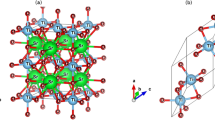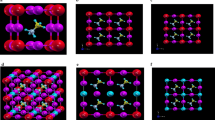Abstract
The present study aims to investigate the structural and optoelectronic properties of the InTe cubic monochalcogenide for its application in the field of photovoltaics as a solar reflector, owing to its high optical reflectivity in the visible and ultraviolet range. We focused on this material due to its limited exploration in the literature. These studies were conducted using density functional theory (DFT), employing the WIEN2k software and the full-potential linearized augmented plane wave (FP-LAPW) method. The Local Density Approximation (LDA) was used as an approximation for considering the electron exchange–correlation energy. We optimized the volume to obtain the optimized cell structure based on the minimum energy criterion, which will be used in subsequent calculations. The calculated structural parameters closely align with experimental values. The band structure and density of states (DOS) calculations indicate that the InTe cubic monochalcogenide is metallic, with a total density (TDOS) at the Fermi level of approximately 1.2 states/eV. Optical properties were also calculated for radiations up to 14 eV. The results suggest that this material could be employed as an efficient solar reflector to mitigate heating effects from solar radiation, thereby improving the efficiency of photovoltaic installations through the judicious use of InTe reflective material.









Similar content being viewed by others
Data availability
The data that supports the findings of this study have been included in this article.
References
S. Misra et al., Synthesis and physical properties of single-crystalline InTe: towards high thermoelectric performance. J. Mater. Chem. C 9(15), 5250–5260 (2021). https://doi.org/10.1039/D1TC00876E
L. Zhou, S. Yan, T. Lu, Y. Shi, J. Wang, F. Yang, Indium telluride nanotubes: Solvothermal synthesis, growth mechanism, and properties. J. Solid State Chem. 211, 75–80 (2014). https://doi.org/10.1016/j.jssc.2013.11.033
M. Zapata-Torres, J.L. Peña, Y.P. Mascarenhas, R. Castro-Rodríguez, M. Meléndez-Lira, O. Calzadilla, Grown of InTe films by close spaced vapor transport. Superf. y vacío 13, 69–71 (2001)
J.-J. Wang, F.-F. Cao, L. Jiang, Y.-G. Guo, W.-P. Hu, L.-J. Wan, High performance photodetectors of individual InSe single crystalline nanowire. J. Am. Chem. Soc. 131(43), 15602–15603 (2009). https://doi.org/10.1021/ja9072386
V. Rajaji et al., Pressure induced band inversion, electronic and structural phase transitions in InTe: a combined experimental and theoretical study. Phys. Rev. B 97(15), 155158 (2018). https://doi.org/10.1103/PhysRevB.97.155158
T. Chattopadhyay, R.P. Santandrea, H.G. Von Schnering, Temperature and pressure dependence of the crystal structure of InTe: a new high pressure phase of InTe. J. Phys. Chem. Solids 46(3), 351–356 (1985). https://doi.org/10.1016/0022-3697(85)90178-7
M.K. Jana, K. Pal, U.V. Waghmare, K. Biswas, The origin of ultralow thermal conductivity in InTe: lone-pair-induced anharmonic rattling. Angew. Chem. Int. Ed. 55(27), 7792–7796 (2016). https://doi.org/10.1002/anie.201511737
Chatfopadhyay, T. A new high pressure phase of InTe
S. Pal, D.N. Bose, S. Asokan, E.S.R. Gopal, Anisotropic properties of the layered semiconductor InTe. Solid State Commun. 80(9), 753–756 (1991). https://doi.org/10.1016/0038-1098(91)90902-8
M.K. Jacobsen, Y. Meng, R.S. Kumar, A.L. Cornelius, High pressure structural and transport measurements of InTe, GaTe, and InGaTe2. J. Phys. Chem. Solids 74(5), 723–728 (2013). https://doi.org/10.1016/j.jpcs.2013.01.011
A. Bera et al., Sharp Raman anomalies and broken adiabaticity at a pressure induced transition from band to topological insulator in Sb 2 Se 3. Phys. Rev. Lett. 110(10), 107401 (2013). https://doi.org/10.1103/PhysRevLett.110.107401
Y.A. Sorb et al., « Pressure-induced electronic topological transition in Sb2 S3. J. Phys. Condens. Matter 28(1), 015602 (2016). https://doi.org/10.1088/0953-8984/28/1/015602
K. Saha, K. Légaré, I. Garate, Detecting band inversions by measuring the environment: fingerprints of electronic band topology in bulk phonon linewidths. Phys. Rev. Lett. 115(17), 176405 (2015). https://doi.org/10.1103/PhysRevLett.115.176405
V. Rajaji et al., Pressure induced structural, electronic topological, and semiconductor to metal transition in AgBiSe2. Appl. Phys. Lett. 109(17), 171903 (2016). https://doi.org/10.1063/1.4966275
A. Bera, A. Singh, D.V.S. Muthu, U.V. Waghmare, A.K. Sood, Pressure-dependent semiconductor to semimetal and lifshitz transitions in 2H-MoTe$_2$: raman and first-principles studies. J. Phys. Condens. Matter 29(10), 105403 (2017). https://doi.org/10.1088/1361-648X/aa55a1
D. K. Schwarz, An Augmented Plane Wave + Local orbitals program for calculating crystal properties
S.-H. Wei, Recent development of APW-based methods and Band structure of semiconductors
Q. Wu, W. Yang, Empirical correction to density functional theory for van der Waals interactions. J. Chem. Phys. 116(2), 515–524 (2002)
A. Van De Walle, G. Ceder, Correcting overbinding in local-density-approximation calculations. Phys. Rev. B 59(23), 14992–15001 (1999). https://doi.org/10.1103/PhysRevB.59.14992
F.D. Murnaghan, The compressibility of media under extreme pressures. Proc. Natl. Acad. Sci. 30(9), 244–247 (1944). https://doi.org/10.1073/pnas.30.9.244
F. Bechstedt, F. Fuchs, G. Kresse, Ab-initio theory of semiconductor band structures: new developments and progress. Phys. Status Solidi B 246(8), 1877–1892 (2009). https://doi.org/10.1002/pssb.200945074
I. Khan, I. Ahmad, B. Amin, G. Murtaza, Z. Ali, Bandgap engineering of Cd1−xSrxO. Phys. B Condens. Matter 406(13), 2509–2514 (2011). https://doi.org/10.1016/j.physb.2011.03.042
I. Khan, I. Ahmad, H.A.R. Aliabad, M. Maqbool, DFT-mBJ studies of the band structures of the II-VI semiconductors. Mater. Today Proc. 2(10), 5122–5127 (2015). https://doi.org/10.1016/j.matpr.2015.11.008
A.B. DjurisÏicÂ, E.H. Li, Optical dielectric function of semiconductors. Thin Solid Films 364(1–2), 239–243 (2000)
R.L. Olmon et al., Optical dielectric function of gold. Phys. Rev. B 86(23), 235147 (2012). https://doi.org/10.1103/PhysRevB.86.235147
G. Gu, Fundamentals of semiconductors: physics and materials properties
J. A. R. Samson, D. L. Ederer, Éd., (1998) Vacuum ultraviolet spectroscopy. in experimental methods in the physical sciences, no. v. 31-<32 >. San Diego: Academic Press
I. Guesmi, A. Challioui, L. El Farh, S. Malki, Z. Darhi, Study of the structural, electronic and optical properties of 1T-ZrX2 materials (X=S, Se, Te). Solid State Phenom. 335, 3–13 (2022). https://doi.org/10.4028/p-775o97
R. Saniz, L.-H. Ye, T. Shishidou, A.J. Freeman, Structural, electronic, and optical properties of NiAl 3: first-principles calculations. Phys. Rev. B 74(1), 014209 (2006). https://doi.org/10.1103/PhysRevB.74.014209
Z. Darhi, S. Malki, H. Abbadi, L. El Farh, I. Guesmi, A. Challioui, Ab-initio calculation of the structural, electronic, mechanical, optical, and thermoelectric properties of orthorhombic ZnAs compound. Phys. B Condens. Matter 654, 414722 (2023). https://doi.org/10.1016/j.physb.2023.414722
S.A. Khan, A.H. Reshak, Z.A. Alahmed, Electronic band structure and optoelectronic properties of SrCu2X2 (X = As, Sb): DFT calculation. J. Mater. Sci. 49(14), 5208–5217 (2014). https://doi.org/10.1007/s10853-014-8230-3
A. Bakhshayeshi, M.M. Sarmazdeh, R.T. Mendi, A. Boochani, First-principles prediction of electronic, magnetic, and optical properties of Co2MnAs full-heusler half-metallic compound. J. Electron. Mater. 46(4), 2196–2204 (2017). https://doi.org/10.1007/s11664-016-5158-1
H. Shinotsuka, H. Yoshikawa, S. Tanuma, First-principles calculations of optical energy loss functions for 30 compound and 5 elemental semiconductors. E-J. Surf. Sci. Nanotechnol. 19, 70–87 (2021). https://doi.org/10.1380/ejssnt.2021.70
R.F. Egerton, Electron energy-loss spectroscopy in the electron microscope, google livres
M. Dressel, G. Grüner, Electrodynamics of solids: optical properties of electrons in matter (Cambridge University Press, Cambridge New York Melbourne, 2002)
M. Usman, J.U. Rehman, M.B. Tahir, A. Hussain, First-principles calculations to investigate the effect of Cs-doping in BaTiO3 for water-splitting application. Solid State Commun. 355, 114920 (2022). https://doi.org/10.1016/j.ssc.2022.114920
Author information
Authors and Affiliations
Contributions
Mounaim Bencheikh: Study conceptualization, Investigation, Validation, Data curation and software, writing and main text editing, article revision, and approval of the final manuscript edition. Larbi El Farh: Critically reviewed and edited the manuscript, played a key role in research design, study supervision, and methodology. Allal Challioui: Formal analysis and methodology. Malki Siham: Contributed to validation, and manuscript proofreading. Zakariae Darhi: Validation and software. Ibtissam Guesmi: Data curation and software. Savas Kaya: Formal analysis.
All authors participated in the revision and approval of the final version of the manuscript.
Corresponding author
Ethics declarations
Conflict of interest
The authors declare that they have no known competing financial interests or personal relationships that could have appeared to influence the work reported in this paper.
Additional information
Publisher's Note
Springer Nature remains neutral with regard to jurisdictional claims in published maps and institutional affiliations.
Rights and permissions
Springer Nature or its licensor (e.g. a society or other partner) holds exclusive rights to this article under a publishing agreement with the author(s) or other rightsholder(s); author self-archiving of the accepted manuscript version of this article is solely governed by the terms of such publishing agreement and applicable law.
About this article
Cite this article
Bencheikh, M., El Farh, L., Malki, S. et al. Determination of the structural and optoelectronic properties of InTe cubic monochalcogenide using the WIEN2k code for its application in photovoltaics. J Opt (2024). https://doi.org/10.1007/s12596-024-01775-4
Received:
Accepted:
Published:
DOI: https://doi.org/10.1007/s12596-024-01775-4




